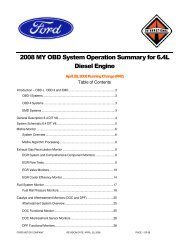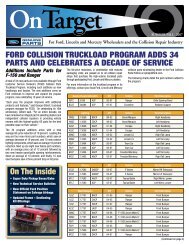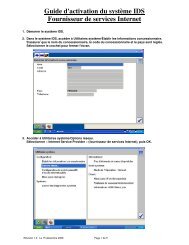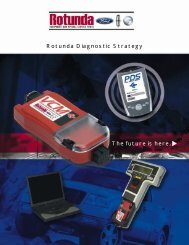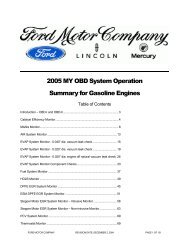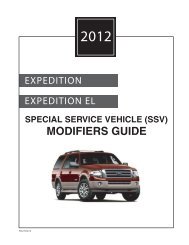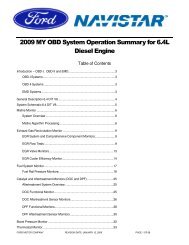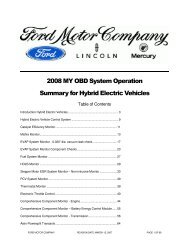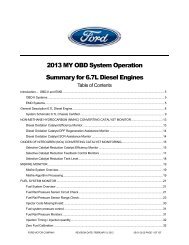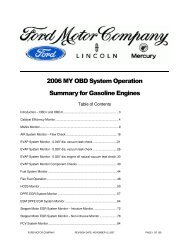2005 MY OBD System Operation Summary for Gasoline Engines
2005 MY OBD System Operation Summary for Gasoline Engines
2005 MY OBD System Operation Summary for Gasoline Engines
Create successful ePaper yourself
Turn your PDF publications into a flip-book with our unique Google optimized e-Paper software.
$44%$> );;The Digital Transmission Range (DTR) sensor provides a single analog and three digital inputs to the PCM. ThePCM decodes these inputs to determine the driver-selected gear position (Park, Rev, Neutral, OD, 2, 1).This input device is checked <strong>for</strong> opens and invalid input patterns. (P0708 P0705)The Turbine Shaft Speed (TSS) sensor and Output Speed Sensor (OSS) are inputs that are checked <strong>for</strong>rationality. Provided one of the two speed sensors has sufficient signal and engine load is high enough and theengine speed is above the torque converter stall speed, it can be inferred that the vehicle must be moving. If thereis insufficient output from the TSS sensor, a malfunction is indicated (P0715). If there is insufficient output from theOSS sensor, a malfunction is indicated (P0720).;Shift SolenoidsThe Shift Solenoid (SSA, SSB, SSC, and SSD) output circuits are checked <strong>for</strong> opens and shorts by the PCM bymonitoring the status of a feedback circuit from the output driver (P0750 SSA, P0755 SSB, P0760 SSC, andP0765 SSD).All vehicle applications will utilize an inductive signature circuit to monitor the shift solenoids functionally. The ISIGcircuit monitors the current signature of the shift solenoid as the solenoid is commanded on. A solenoid thatfunctions properly will show a characteristic decrease in current as the solenoid starts to move. If the solenoid ismalfunctioning, the current will not change (P1714 SSA, P1715 SSB, P1716 SSC, P1717 SSD). The ISIG testruns in conjunction with the other transmission functional tests. The lack of communication between the ISIG chipand the PCM microprocessor is also monitored (P1636).Torque Converter ClutchThe Torque Converter Clutch (TCC) output circuit is a duty-cycled output that is checked electrically <strong>for</strong> opens andshorts by the PCM by monitoring the status of a feedback circuit from the output driver (P0743).These vehicle applications will utilize an inductive signature circuit to monitor the torque converter clutch. The ISIGcircuit monitors the current signature of the TCC solenoid as the solenoid is commanded on. A solenoid thatfunctions properly will show a characteristic decrease in current as the solenoid starts to move. If the solenoid ismalfunctioning, the current will not change (P1740). The ISIG test is run in conjunction with the other transmissionfunctional tests. The lack of communication between the ISIG chip and the PCM microprocessor is also monitored(P1636).Electronic Pressure Control OutputThe EPC solenoid is a variable <strong>for</strong>ce solenoid that controls line pressure in the transmission. The EPC solenoidhas a feedback circuit in the PCM that monitors EPC current. If the current indicates a short to ground (lowpressure), engine torque may be reduced to prevent damage to the transmission. (P1747, PCA)FORD MOTOR COMPANY REVISION DATE: APRIL 28, 2004 PAGE 109 OF 131



